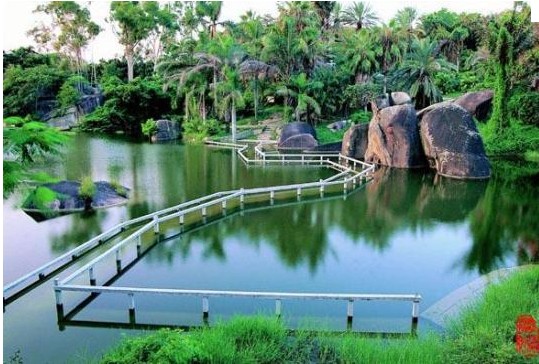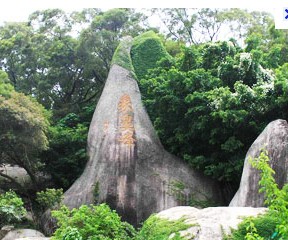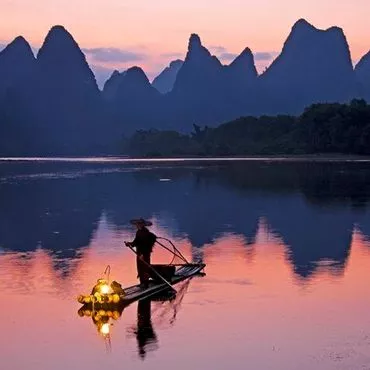Wanshi Rock Tourist Area
The Wanshi Rock Tourist Area is a natural landscape of lakes and mountains in the north of the Lion Hill, which lies on the east of Xiamen city proper. It is a major scenic spot known for its caves and egg-shaped granite rocks, which blend in harmony with the flowers and trees of the botanical garden near Wanshi Lake. The botanical garden features more than 3,000 species of tropical and subtropical plants kept in more than 20 nurseries. The Hongshan Amusement Park is also located here at the southwestern foot of the hill. This tourist area can be reached by bus from downtown Xiamen.


The major scenic spots around are Wanshi Botanical Garden, Wanshi Rock, Taiping Rock, Tiger Brook Rock, Heaven Border Temple, White Deer Cave, etc.
The Wangshi (10,000 stones) Rock lies on the south of Wangshi Reservoir and the north of Taiping Rock. Queer peaks, odd stones, luxuriant forests and cultural relics spread over the hillside. Amid the myriad rocks is an elaborate hall--Wangshilian Temple. Step on the rock and take a broad view, your sight is dominated with stones and rocks, lying at sixes and sevens. Beneath the rock is a deep spring named "Minor Peach Garden". Look right, you will find a mount with the shape of the elephant trunk, thus it is named Elephant Trunk Mount.
The garden combined with historic remains and rocky hills is unique in China. To meet the needs of both scientists and tourists, more than 20 special nurseries and plots are classified and over 3,000 valuable species of tropical and subtropical plants have been introduced and domesticated here, thus forming "many gardens within one garden". All of them are meticulously scattered around Wangshi Lake. Among the many rare plant species in the garden, one can find "living fossils"-- metasequoia and gingko, three of the world's five best ornamental trees-- Golden Larch, Deodar Cedar and Hoop Pine. Lush and green, the garden is really a "Green Museum".
On the west of Wangshi Rock is Drunken God Rock. Heaven Border Temple is built there at the beginning of the Qing Dynasty. In the old times, monks there always stroke the bell 108 time in early morning which could be heard far and near. Thus people called this "Morning Bell From Heaven Border" and listed it among the "Eight Minor Landscapes of Xiamen". Ascend step by step from the back of the temple, one come to other sceneries like "Ask Buddha the Way", " "God Ruin Rock", "Stone Chessboard", "Buddha Bathing Basin" and "Long Howl Cave". Camel Peak is the summit and one can catch the whole sight of Xiamen and be feeling extremely relaxed there.
One can climb up Taiping Rock from the stone path in front of Wangshi Rock. Here is chacracterized by craggy stones, hidden caves, quiet and beautiful woods and gurgling streams. In recent years, new temples have been built here according to but surpassing their initial appearance. Visitors can have a rest and taste tea in a tearoom there. Close to the temple are a pile of huge rocks overlaying each other to form a mouth that is laughing with delight. People gave it the name "Taiping Laughing Stone".
The Tiger Brook Rock lies on the southwest of Wangshi Rock. There is a temple, Dongling Temple, also called Jade Screen Temple, built during Emperor Wangli’s reign of the Ming Dynasty. The temple had experienced rises and declines several times. Rebuilt in 1984, the present construction comes out of a huge rock and backed by a hill. Known sceneries there include Tiger Teeth Cave, Night Moon Cave, Clipping Sky Pathway, Flying Whale Rock. At night when the moon is shining upon, the rock is overwhelmed by a touch of mystery and people found it the best spot to admire the moon when it comes the Mid-autumn Moon Festval. One of the "Eight Major Landscapes of Xiamen", "Night Moon at Tiger Brook" was born here due to this reason.
The White Deer Cave was built at the back of the Tiger Brook Rock during the Ming Dynasty and was rebuilt during Emperor Qianlong’s Reign of the Qing Dynasty when Three Treasures Hall, Whorshipping Heaven Cave and Universe Cave were added.













